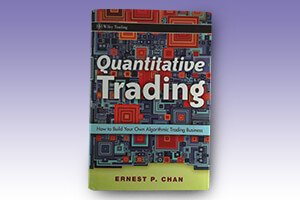Unveiling the Algorithmic Edge:
An Analysis of Ernest Chan’s “Quantitative Trading”
In the ever-evolving landscape of financial markets, Ernest Chan’s “Quantitative Trading: How to Build Your Own Algorithmic Trading Business” stands as a cornerstone guide for aspiring quantitative traders. First published in 2008 and revised in 2019, the book offers a comprehensive roadmap for navigating the world of algorithmic trading, equipping readers with the knowledge and tools to design and implement their own systematic trading strategies.
Introducing the author
Ernest Chan, the author of “Quantitative Trading,” is a recognized expert in the field of algorithmic trading. While details beyond his expertise are limited, his reputation is built on his experience as a successful independent trader and consultant. This practical background allows him to craft a guidebook that goes beyond theory, offering insights into building a sustainable algorithmic trading business.
Chan, a recognized authority in quantitative trading, demystifies the subject for both experienced traders seeking to integrate algorithmic approaches and newcomers eager to enter this dynamic field. His book delves into the core concepts of quantitative trading, from backtesting and risk management to statistical analysis and programming for algorithmic execution.

About the book
“Quantitative Trading” is not merely a technical manual. Chan adopts a holistic approach, addressing the “whats,” “whoms,” and “whys” of quantitative trading in the opening chapter. This sets the stage for a practical exploration, guiding readers through the process of building their own algorithmic trading business. The book’s focus on establishing a sustainable business framework distinguishes it from other quantitative trading resources.
The structure of the book
The book’s structure provides a clear path for mastering the intricacies of algorithmic trading. Examining the chapter headings offers valuable insights into the key areas Chan explores:
The Whats, Whos, and Whys of Quantitative Trading:
This introductory chapter likely lays the groundwork, defining quantitative trading, exploring the profiles of successful quantitative traders, and outlining the potential benefits and challenges associated with this approach.
- Subsequent chapters delve deeper, potentially tackling topics like: Essential Quantitative Tools: Equipping readers with the mathematical and statistical foundations crucial for analyzing market data and developing trading strategies.
- Technical Analysis for Algorithmic Trading: This section might explore how classical technical indicators can be integrated into quantitative models and potentially introduce more advanced concepts.
- Risk Management for Algorithmic Trading: A critical component, this chapter might discuss techniques for measuring and managing risk in algorithmic strategies, potentially covering areas like position sizing and stop-loss orders.
- Building and Testing Algorithmic Trading Systems: Here, the focus might shift towards the practical aspects of strategy development, including backtesting methodologies and performance evaluation techniques.
- Transaction Costs and Market Impact: Algorithmic trading can be impacted by transaction costs and market microstructure. This section might equip readers with the knowledge to mitigate these effects.
- Live Trading and Execution: Transitioning from backtesting to live markets requires careful consideration. This chapter might discuss critical factors like order types, execution algorithms, and risk management protocols in a live trading environment.

last word
In conclusion, Ernest Chan’s “Quantitative Trading” offers a comprehensive guide for traders seeking to enter the world of algorithmic trading. By meticulously structuring the book around key themes and providing a roadmap through the chapter headings, Chan empowers readers to embark on this data-driven approach to the market. The book equips aspiring quantitative traders with the knowledge and tools to not only build algorithmic strategies but also navigate the essential aspects of risk management, infrastructure development, and the unique psychological demands of this challenging yet rewarding field.
It is important to note that the specific chapter breakdown might vary slightly depending on the edition you consult. However, the core themes explored by Chan equip readers with a robust understanding of quantitative trading methodologies, preparing them to navigate the algorithmic frontier of the financial markets.
Happy trading
may the pips be ever in your favor!








